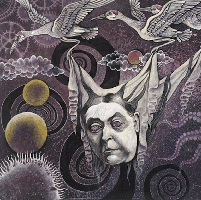by Jacqueline Jouret
The Legendary Pink Dots weave a rich tapestry of shimmering textures, staccato bursts, and haunting Eastern melodies. It’s musical mysticism, a tonal kaleidoscope. They concoct a mixture of power and delicacy, music which gives a sense of confinement and liberation at the same time. It isn’t about rebellion so much as transcendence, and it speaks less to the body and soul than to the mind and spirit. It has nothing to do with rock and roll.
It’s psychedelia, says Pink Dots founder and vocalist Edward Ka-Spel, “with the real meaning of it, the exploratory sense of psychedelia. I would have to place its roots in what started here [in San Francisco, where the interview took place] and in London– and all over the Western world in the ’60s. Of course, we don’t sound like anything from the ’60s because we’re continuing to explore. We’re just picking up the threads and going on, not going back. Something beautiful happened then, but somehow it stopped. We’d like to get it back on the right path.”
To that end, The Maria Dimension, their latest album for Play It Again Sam, uses sitar, lyre, glockenspiel, and teacups along with keyboards, horns, guitars, and drums. As a band who’ve abandoned their English home to put down roots in Europe, Pink Dots take their musical cues from German groups like Can and Faust, and from experimental composers like Stockhausen, Xenakis, and Ligeti. They take inspiration from these sculptors of noise, occasionally filtering the sounds through an English folk sensibility. The result is more truly psychedelic in the sense of mind-expansion or enlightenment than would be possible if the band were simply copying the Electric Prunes or even Pink Floyd. The Pink Dots play with the sounds available from every source and let the strands of noise intermingle to create intricate landscapes of the imagination. Drums aren’t used to keep a beat (there really isn’t one, although the music is quite rhythmic), but to punctuate the sound. Guitars build texture and contrast, not riffs and repetition.
In a way, listening to a Pink Dots record is like watching the shifts of the landscape from the window of a train. The music is a constantly changing tableau of shapes and images. When asked to explain the songs’ inspiration, Ka-Spel replied, “In a way, it can be almost anything. It can be driving through absolutely flat land for miles and miles. I’m not a person who gets bored. I have the receptor up all the time. I’m taking in every kind of stimulus. Sometimes it’s fantasy as well. You’re imagining what’s behind a little hill that suddenly juts up. Your mind wanders…
“There are certain places that hit you very hard. The Tower (1984) is basically about England, but it wasn’t an English city that inspired it. (The Dots formed in London but now live in Holland.) It was Nuremburg, Germany, which is almost paradiselike, in its way. It’s an extremely beautiful city. You’re so aware of its history. It’s sort of got this scar that cannot be removed, and a melancholy amongst the young people and a defensiveness amongst a lot of the older people. You’re constantly feeling this as you’re walking the streets.”
The Maria Dimension, however, is pervaded throughout by Arabic touches which call to mind (for this listener, at least), images of ancient stone cities and the desolate grandeur of the desert colliding with machinery and the modern age.
Ka-Spel has a different take on it altogether. “It’s a strange thing,” he said. “It’s like I’m floating across a lake on a little cloud, like I’m looking into this immense, beautiful, blue twilight world. I like images like that, slightly hallucinatory….”
“We’ve just travelled through the desert,” he continued, “The desert’s a fascinating place. There’s something so ancient about it, something so powerful…
“It’s like another head space altogether. I’ve just been reading the biography of Jim Morrison, and I can see why he went into the desert so much, and what he drew from the feel of the desert.”
Like those of his psychedelic predecessors, Ka-Spel’s lyrics tend toward the hallucinatory, filled with elaborate images like “the melting red rungs of a ladder that leads high to a darkening moon.” There’s a sort of Druidic naturalism about songs like “The Grain Kings,” as Ka-spel sings, “We will sow the seeds together/We shall feed the fertile ground.” A Romanticism emerges in “Evolution,” a longing for the time before the desecration: “If time was never measured, only killed in pleasure gardens of our making. If we’d never taken anything, but only given… If we could forgive, forget and rearrange the patterns. If you’d never thrown that stone or split the atom.”
Indeed, much of what the Legendary Pink Dots are communicating is a sense of the immense possibilities for endlessly varied perceptions which exist for us all, if we open ourselves up.
The band has acquired a devoted but small following in the US (contrasting with their following in Europe: devoted and huge). During their recent performance at DNA Lounge in San Francisco, the audience was held rapt by a powerful, majestic set which balanced intricacy with strength. The musical structures loosened up to allow for improvisation and interplay between band members. Niels Van Hoorn’s clarinets and saxophones gained in prominence, revealing themselves as the dynamic centerpiece of the Pink Dots’ sound. The horns alternately drove the music and wafted overhead like the voice of an imam chanting from the minaret. The Eastern influences lent a calm, sensual allure, and the mood of the audience went with it. Legendary Pink Dots weren’t a band one went to see, but a band one went to listen to and absorb.
“I want to turn their inside outside, in a way,” Ka-Spel said. “I want them to cry with it, I want them to laugh with it. I want to strike them on such an emotional level, because all my emotions go into it, and I don’t want to hold anything back. I want them to experience much beauty, along with the darker side, as well. It’s all mixed, there’s all colors.”




 The Legendary Pink Dots’ discography is so expansive that it’s difficult to say something about their music with full authority. The Dots’ founding members—Edward Ka-Spel and Phil Knight—may not even know for themselves how many albums they have released by this point, although it’s safe to say the number of studio records exceeds 40. In 2014 alone, the band released one LP—10 to the Power of 9—two live albums and two compilations. One of those compilations, 12 Steps Off the Path, appeared in my inbox to review. Although there’s no knowing why 12 Steps Off the Path arose as the victor among the Legendary Pink Dots’ 2014 output, it does highlight the things that can be said about the band’s music—namely, it’s dark and filled with esoteric mystique, it’s loud, it’s psychedelic, it’s synthy, it’s gothy, and it’s still more thrilling today than many of the most hotly praised albums of the year.
The Legendary Pink Dots’ discography is so expansive that it’s difficult to say something about their music with full authority. The Dots’ founding members—Edward Ka-Spel and Phil Knight—may not even know for themselves how many albums they have released by this point, although it’s safe to say the number of studio records exceeds 40. In 2014 alone, the band released one LP—10 to the Power of 9—two live albums and two compilations. One of those compilations, 12 Steps Off the Path, appeared in my inbox to review. Although there’s no knowing why 12 Steps Off the Path arose as the victor among the Legendary Pink Dots’ 2014 output, it does highlight the things that can be said about the band’s music—namely, it’s dark and filled with esoteric mystique, it’s loud, it’s psychedelic, it’s synthy, it’s gothy, and it’s still more thrilling today than many of the most hotly praised albums of the year.